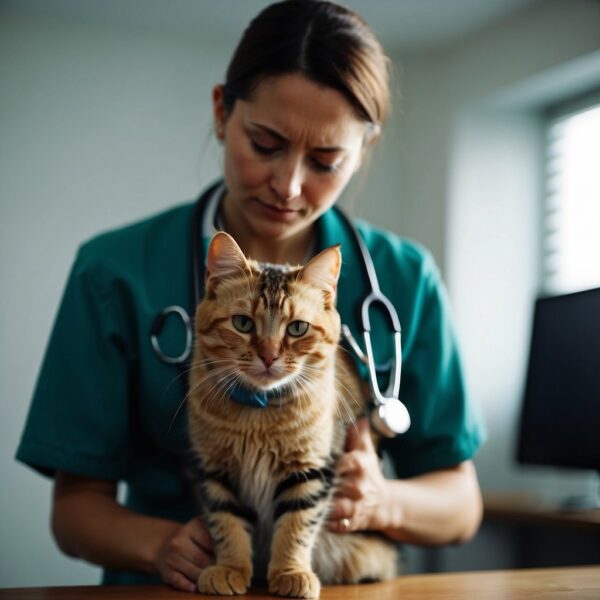
Cat Asthma Symptoms: Your cat’s Respiratory Health
Cat asthma, also known as feline asthma, is a common respiratory condition in cats that resembles human asthma. It’s characterized by chronic inflammation of the small airways within the lungs. Allergic reactions to environmental allergens such as pollen, mold, dust, and smoke are often the underlying cause of these symptoms. Cats with asthma may experience episodes of difficulty breathing, coughing, and wheezing.
The symptoms of feline asthma can range from mild to severe and can be triggered or exacerbated by stress or physical activity. Cats experiencing an asthma attack may exhibit a hunched posture with an extended neck, struggling to breathe. In severe cases, they could have a rapid breathing rate, appear lethargic, or even have a bluish tinge to their lips and gums due to inadequate oxygen levels.
Key Takeaways
- Cat asthma is a condition where cats experience chronic inflammation of the airways.
- Symptoms include difficulty breathing, coughing, and wheezing, with severity ranging from mild to life-threatening.
- Proper diagnosis, treatment, and management are crucial for maintaining a cat’s quality of life with asthma.

Understanding Cat Asthma Symptoms
Cat asthma is a common respiratory condition in cats, resembling human asthma in its effects on the airways and its response to environmental triggers. It is crucial for cat parents to recognize the causes and symptoms to manage this chronic disease effectively.
Definition and Overview
Feline asthma is a chronic inflammatory disease of the lower airways within the lungs. This condition causes periodic constriction and narrowing of the airways, which can lead to difficulty breathing, wheezing, and coughing.
Causes of Cat Asthma
The exact cause of feline asthma is not fully understood; however, it is generally thought to be an allergic reaction to inhaled allergens. Common triggers include dust, pollen, mold, mildew, perfume, cigarette smoke, and household cleaners.
Common Symptoms
Cats with asthma exhibit symptoms that range from mild to severe respiratory distress. Common signs include:
- Wheezing: Whistling sound while breathing
- Coughing or Hacking: A persistent cough resembling an attempt to clear the throat
- Difficulty and Rapid Breathing: Increased effort to breathe and an elevated respiratory rate
- Open-mouth Breathing: Breathing with the mouth open, which is uncommon in cats
Risk Factors
Certain factors increase the likelihood of a cat developing asthma. These include:
- Breed predisposition (Siamese cats may be more susceptible)
- Obesity, which can worsen respiratory function
- Pre-existing parasitic infections, such as heartworm
Pathophysiology
The pathophysiology of feline asthma involves chronic inflammation of the airways, leading to excessive mucus production, airway constriction, and immune response activation. Over time, this can result in permanent changes to the lung structure.
Comparing Asthma in Cats and Humans
Feline asthma is similar to human asthma in that both are responses to allergens and involve inflammation and narrowing of the airways. The main difference lies in the types of allergens that affect cats and the methods used for diagnosis and treatment.
Other Conditions to Consider
While asthma is a common culprit, other conditions can mimic its symptoms:
- Bronchitis
- Pneumonia
- Respiratory infections
- Heart conditions
When noticing respiratory distress in a cat, it is essential to consult a veterinarian for a proper diagnosis and an appropriate treatment plan.

Diagnosing Cat Asthma
The accurate diagnosis of cat asthma involves a series of steps, beginning with observing clinical signs and followed by a thorough examination and specific diagnostic tests conducted by a veterinarian.
Recognizing the Signs
The initial step in diagnosing cat asthma includes the recognition of symptoms by the cat parent. Cats with asthma may display:
- Coughing: A persistent cough that doesn’t resolve itself.
- Difficulty Breathing: May manifest as rapid or labored breathing.
- Wheezing: Audible high-pitched sounds when breathing.
- Open-Mouth Breathing: Less common but indicative of severe breathing difficulty.
- Distress: General behavior change indicating discomfort or pain.
Veterinary Exam and Consultation
After noticing cat asthma symptoms, the next critical step is a consultative exam by a veterinarian. The exam typically includes:
- History and Assessment: The vet will take a detailed medical history, focusing on the frequency and severity of symptoms.
- Physical Examination: Specifically, checking the cat’s gums for color, which can indicate oxygen levels, and auscultating the lungs for abnormal sounds.
Diagnostic Tests
Veterinary diagnostic tests essential for diagnosis may include:
- Chest X-Rays: To visualize the lungs and airways for signs of inflammation or other lung conditions.
- Bronchoscopy: To inspect the airways and collect samples for culture.
- Culture: To rule out infections that could be causing symptoms.
- Blood Tests and Urinalysis: To assess overall health and rule out other diseases.
- Heartworm Test: To check for heartworm, which can cause similar respiratory symptoms.
Interpreting Test Results
Experienced veterinarians will analyze the results from various tests to make a diagnosis:
- Radiographs: Revealing structural changes in the lungs and bronchial patterns associated with asthma.
- Immune Cell Count: High levels of certain immune cells in blood or samples can indicate an allergic reaction.
- Parasite Evaluation: Ensuring that parasites are not the underlying cause of respiratory distress.
- Response to Treatment: Sometimes, a trial of aerosol therapy can help confirm asthma if symptoms improve.
Through these methods, a veterinarian can distinguish asthma from other respiratory conditions and proceed with a tailored treatment plan.

Treatment and Management
Effective treatment and management of cat asthma involves a multi-faceted approach that includes medical interventions, avoidance of triggers, and lifestyle adjustments to minimize the occurrence and severity of asthma attacks.
Medical Treatments
For immediate relief, bronchodilators may be prescribed by the vet, as they act to widen the airways and make breathing easier. Corticosteroids are commonly used to control inflammation in the lungs. Treatment may be administered orally, via injection, or through an inhaler designed for cats. It’s essential for cat parents to work closely with their vet to determine the appropriate medication and dosage for their pet’s specific needs.
- Bronchodilators: Provide quick relief.
- Corticosteroids: Reduce inflammation long-term.
Managing Asthma Triggers
Identifying and minimizing triggers is crucial in managing asthma. Common irritants include smoke, dust, perfumes, and aerosol sprays. Switching to dust-free cat litter, avoiding the use of candles and fabric softeners, and ensuring a smoke-free environment are key steps. Additionally, incorporating HEPA air filters can significantly reduce airborne allergens.
- Avoid smoke and dust.
- Use dust-free cat litter.
- Maintain a smoke-free environment.
Long-Term Management Strategies
Long-term management centers around maintaining a stable environment and supporting the cat’s overall health. Control of environmental allergens and regular vet check-ups are vital. Weight control through diet and exercise helps prevent obesity, which can exacerbate asthma symptoms. Supplements like omega-3 fatty acids may benefit lung health.
- Regular vet check-ups.
- Diet and exercise for weight control.
Emergency Care for Severe Attacks
In the event of a severe asthma attack, immediate veterinary care is imperative. Symptoms such as rapid breathing, difficulty breathing, lethargy, and weakness signify an emergency. Vets may provide oxygen therapy or anesthesia for intubation. If vomiting occurs, it heightens the urgency as it can further compromise breathing.
- Seek immediate vet care.
- Be aware of emergency symptoms like rapid breathing and difficulty breathing.

Living with a Cat with Asthma
Caring for a cat with asthma involves creating a supportive environment that minimizes triggers and maintaining a diet that supports lung health. Addressing these two critical areas can significantly control symptoms and improve your cat’s quality of life.
Home Environment Adjustments
Creating a stress-free and clean air environment is vital for a cat with asthma. Reducing potential triggers such as dust, smoke, and household cleaners with strong odors is essential. Use these strategies:
- Air Filters: Install HEPA air filters to capture fine particles and reduce airborne allergens in your home.
- Smoke-Free Zone: Ensure the home is a smoke-free space, as tobacco smoke can exacerbate asthma symptoms.
- Avoid Strong Perfumes: Refrain from using perfumed products, including air fresheners, as they can irritate your cat’s airways.
- Regular Cleaning: Keep your home clean by regularly wiping surfaces and vacuuming to minimize dust accumulation.
Diet and Nutrition
A diet rich in the right nutrients can help manage feline asthma. Focus on these aspects:
- Omega-3 Fatty Acids: Incorporate foods rich in omega-3 fatty acids, such as certain types of fish or supplements, to help reduce inflammation.
- Weight Management: Prevent obesity as it can worsen breathing difficulties. Control your cat’s weight through proper portion sizes and low-calorie foods.
- High-Quality Foods: Choose high-quality cat foods that do not contain additives or fillers that may trigger an allergic response.
Prognosis and Quality of Life
Feline asthma is a chronic condition, but with proper management and treatment, many cats can lead a normal, active life. The prognosis heavily depends on the severity of the condition and how well it is managed.
Expected Outcomes
With a vet’s diagnosis and a tailored treatment plan, the progression of feline asthma can often be controlled. Medication typically helps manage symptoms like coughing, reduce the frequency of asthma attacks, and improve overall quality of life. The expected outcome is a stable condition with fewer emergent situations, although it’s important to note that feline asthma is a chronic disease with no definitive cure.
Monitoring Health and Adjusting Treatment
Regular vet visits are crucial for monitoring a cat’s respiratory health and adjusting treatment as necessary. Important aspects of managing feline asthma include:
- Medication Adjustments: Finding the right medication and dosage can minimize the side effects while effectively controlling asthma symptoms.
- Environmental Management: Reducing potential triggers in the home, such as dust, smoke, or certain sprays, to prevent asthma attacks.
- Monitoring Symptoms: Keeping an eye on changes in the cat’s breathing, frequency of coughing, and overall behavior.
- Emergency Preparedness: Having a plan for urgent treatment if a severe asthma attack occurs.
Effective management and treatment are central to maintaining a good quality of life for cats with asthma.
Frequently Asked Questions
Understanding the signs and management of feline asthma can be critical for maintaining their health and quality of life. This FAQ section addresses some key inquiries cat owners often have.
How do I recognize an asthma attack in my cat?
A cat experiencing an asthma attack may exhibit rapid and laborious breathing, wheezing, persistent coughing, and potentially an exaggerated abdominal effort while breathing.
What are the common triggers for asthma in cats?
The triggers for asthma in cats can vary, but often include allergens such as pollen, smoke, dust, and certain sprays or perfumes. Stress and viral respiratory infections may also prompt asthma symptoms.
Can cats live a full life despite having asthma?
With proper management and treatment, cats diagnosed with asthma can live full and healthy lives. Regular monitoring and adjustments to their lifestyle can mitigate the impact of this condition.
What treatment options are available for a cat with asthma?
Treatment for a cat with asthma may involve bronchodilators, anti-inflammatory drugs such as corticosteroids, and avoidance of known allergens. In some cases, veterinarians may also recommend specific therapies like acupuncture.
How frequently do cats with asthma experience attacks?
The frequency of asthma attacks in cats can vary widely. Some may have infrequent episodes while others may experience more regular occurrences. The severity and frequency of attacks are influenced by factors such as environmental triggers and individual sensitivity.
Are there any specific considerations for feline asthma during the night?
Cats with asthma may display symptoms more prominently at night due to cooler air or the presence of allergens in their sleeping environment. Owners should be observant for any signs of distress and maintain a clean, allergen-reduced area for their cat to sleep.